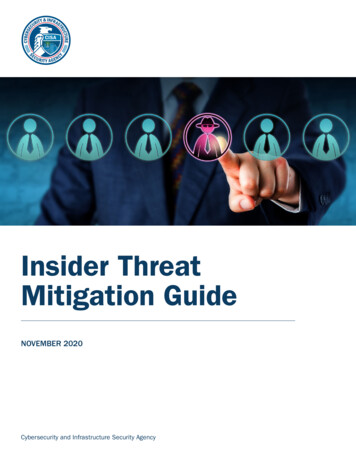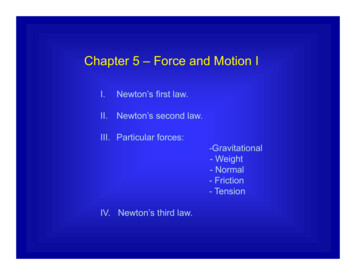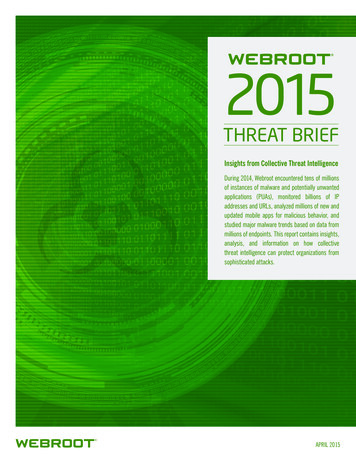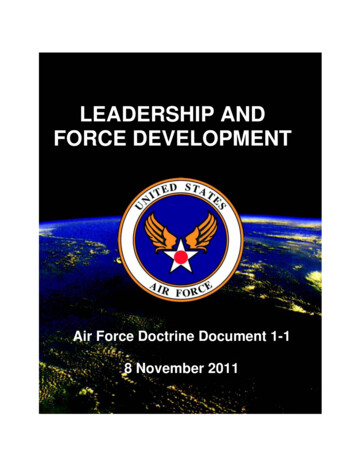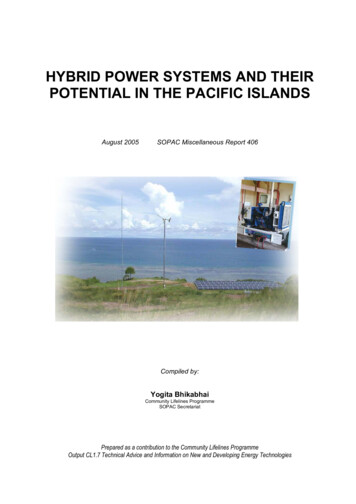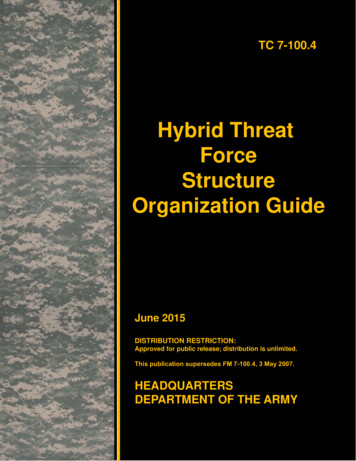
Transcription
TC 7-100.4Hybrid ThreatForceStructureOrganization GuideJune 2015DISTRIBUTION RESTRICTION:Approved for public release; distribution is unlimited.This publication supersedes FM 7-100.4, 3 May 2007.HEADQUARTERSDEPARTMENT OF THE ARMY
This publication is available at Army Knowledge .html).To receive publishing updates, please subscribe athttp://www.apd.army.mil/AdminPubs/new subscribe.asp.
TC 7-100.4HeadquartersDepartment of the ArmyWashington, DC, 4 June 2015Technical CircularNo. 7-100.4Threat Force Structure Organization GuideContentsPagePREFACE. vINTRODUCTION . viChapter 1HYBRID THREAT ROLES AND RELATIONSHIPS IN TRAINING . 1-1Hybrid Threat for the Complex Operational Environment . 1-1Role in Training . 1-2Tie-In with Other Manuals in the 7-100 Series . 1-3Chapter 2HYBRID THREAT FORCE STRUCTURE . 2-1Section I – Threat Forces: Strategic Level . 2-1National-Level Command Structure . 2-1Service Components . 2-2Theater Headquarters . 2-6Section II – Threat Forces: Operational Level . 2-7Section III – Threat Forces: Tactical Level . 2-8Divisions . 2-8Maneuver Brigades . 2-8Battalions . 2-8Companies . 2-8Platoons . 2-9Aviation Units . 2-9Nondivisional Units . 2-9Section IV – Irregular Forces . 2-9Irregular Organizations . 2-10Insurgent Organizations . 2-10Criminal Organizations . 2-14Other Combatants . 2-14Noncombatants . 2-15Section V – Organizational Directories . 2-17Files for OPFOR Units . 2-18Folders for Threat Force Structure . 2-22Distribution Restriction: Approved for public release; distribution is unlimited.4 June 2015i
ContentsChapter 3TASK-ORGANIZING . 3-1Section I Fundamental Considerations . 3-1U.S. Training Requirements . 3-1Hybrid Threat Doctrine . 3-2Section II – Threat Forces: Strategic Level . 3-4Supreme High Command . 3-4Strategic Framework . 3-4Section III – Threat Forces: Operational Level . 3-5Field Group . 3-6Operational-Strategic Command . 3-7Section IV – Threat Forces: Tactical Level . 3-13Tactical Groups . 3-13Detachments . 3-15Integrated Fires Command . 3-16Integrated Support Command . 3-17Internal Task-Organizing . 3-17Special-Purpose Forces . 3-18Internal Security Forces . 3-18Section V Non-State Actors . 3-18Insurgent and Guerrilla Forces . 3-18Other Paramilitary Forces . 3-19Noncombatants . 3-20Section VI – Exploitation of Noncombatants and Civilian Assets . 3-21Military Forces . 3-21Paramilitary Forces . 3-21Section VII Unit Symbols for OPFOR Task Organizations. 3-22Section VIII Building an OPFOR Order of Battle . 3-23Step 1. Determine the Type and Size of U.S. Units . 3-24Step 2. Set the Conditions . 3-24Step 3. Select Army Tactical Tasks . 3-24Step 4. Select OPFOR Countertasks. 3-24Step 5. Determine the Type and Size of Hybrid Threat Units . 3-24Step 6. Review the HTFS Organizational Directories . 3-25Step 7. Compile the Initial Listing of Hybrid Threat Units for the TaskOrganization . 3-25Step 8. Identify the Base Unit . 3-25Step 9. Construct the Task Organization . 3-25Step 10. Repeat Steps 4 through 9 as Necessary. 3-26Chapter 4EQUIPMENT OPTIONS . 4-1Baseline Equipment . 4-1Worldwide Equipment Guide . 4-4Appendix ATHREAT FORCE STRUCTURE ORGANIZATIONAL DIRECTORIESLISTING . A-1Appendix BBUILDING A HYBRID THREAT TASK ORGANIZATION . B-1iiTC 7-100.44 June 2015
ContentsAppendix CLOCAL INSURGENT ORGANIZATION FROM THE HTFSORGANIZATIONAL DIRECTORIES . C-1Appendix DMOTORIZED INFANTRY COMPANY FROM THE HTFSORGANIZATIONAL DIRECTORIES . D-1Appendix EGUERRILLA HUNTER/KILLER COMPANY FROM THE HTFSORGANIZATIONAL DIRECTORIES . E-1GLOSSARY . Glossary-1REFERENCES . References-1INDEX . Index-1FiguresFigure 2-1. National-Level Command Structure and Service Components . 2-2Figure 2-2. Internal Security Forces in the Ministry of the Interior . 2-4Figure 2-3. Peacetime Threat force Structure . 2-7Figure 2-4. Infantry Squad Personnel and Equipment (Example). 2-20Figure 2-5. Basic Listing of Folders in TFS Organizational Directories . 2-23Figure 3-1. Wartime Fighting Force Structure . 3-6Figure 3-2. Allocation of Forces to an OSC (Example) . 3-7Figure 3-3. Possible OSC Organization (Example) . 3-8Figure 3-4. Possible IFC Components in an OSC. 3-9Figure 3-5. Possible RISTA Command in an OSC. 3-11Figure 3-6. OSC Task Organization, with ISC Example . 3-12Figure 3-7. Possible DTG Organization (Example) . 3-14Figure 3-8. Possible BTG Organization (Example) . 3-15Figure 3-9. Battalion-Size Detachment (BDET) Example . 3-16Figure 3-10. Company-Size Detachment (CDET) Example . 3-16Figure 3-11. Possible IFC Components in a DTG . 3-17Figure 3-12. OSC Symbol . 3-22Figure 3-13. Motorized Infantry-Based DTG Symbol . 3-22Figure 3-14. Mechanized Infantry-Based DTG Symbol . 3-22Figure 3-15. Tank-Based BTG Symbol . 3-23Figure 3-16. Heliborne Infantry-Based BDET Symbol. 3-23Figure 3-17. Attack Helicopter-Based BDET Symbol . 3-23Figure 3-18. Mechanized Infantry-Based CDET Symbol . 3-23Figure 4-1. Motorized Infantry Company Principal Items of Equipment List . 4-2Figure 4-2. Motorized Infantry Company Personnel and Equipment Chart . 4-3Figure B-1. Basic Task-Organized Hybrid Threat (Example) .B-3Figure B-2. Separate Motorized Infantry Brigade from TFS to Use as a Baseline Unit .B-5Figure B-3. Local Insurgent Organization from HTFS to Use as a Baseline Unit .B-7Figure B-4. Folders for Task Organization .B-94 June 2015TC 7-100.4iii
ContentsFigure B-5. Brigade Tactical Group (Motorized) (Antiarmor-Light) . B-12Figure B-6. Rows 1 and 2 . B-13Figure B-7. BTG (Mtzd) (Antiarmor-Lt) Personnel and Equipment List, Page 1. B-19Figure B-8. BTG (Mtzd) (Antiarmor-Lt) Personnel and Equipment List Continued,Page 2 . B-20Figure B-9. BTG (Mtzd) (Antiarmor-Lt) Personnel and Equipment List Continued,Page 3 . B-21Figure B-10. BTG (Mtzd) (Antiarmor-Lt) Personnel and Equipment List Continued,Page 4 . B-22Figure B-11. BTG (Mtzd) (Antiarmor-Lt) Personnel and Equipment List Continued,Page 5 . B-23Figure B-12. Folders and Files for Task Organization . B-25Figure B-13. Local Insurgent Organization (Affiliated) . B-28Figure B-14. Local Insurgent Organization Equipment (Affiliated) . B-29TablesTable 3-1. Command and Support Relationships . 3-2Table 4-1. Equipment Tier Table (Example) . 4-8Table 4-2. Systems Substitution Matrix (Example) . 4-10Table B-1. Initial Listing of Hybrid Threat Units Required for Task Organization . B-4Table B-2. Specific Units Required for BTG Task Organization . B-5ivTC 7-100.44 June 2015
PrefaceThis training circular (TC) is one of a series that describes the Hybrid Threat Force Structure (HTFS) fortraining U.S. Army commanders, staffs, and units. See the References section for a list of other publications inthis series. (Other publications in the former Field Manual [FM] 7-100 series will be converted to TCs as well.)Together, these TCs outline a Hybrid Threat than can cover the entire spectrum of military and irregularcapabilities against which the Army must train to ensure success in any future conflict.Applications for this series of TCs include field training, training simulations, and classroom instructionthroughout the Army. All Army training venues should use a HTFS based on these TCs, except when missionrehearsal or contingency training requires maximum fidelity to a specific country-based threat or enemy. Evenin the latter case, trainers should use appropriate parts of the Hybrid Threat TCs to fill information gaps in amanner consistent with what they do know about a specific threat or enemy.This publication applies to the Active Army, the Army National Guard (ARNG) /Army National Guard of theUnited States (ARNGUS), and the United States Army Reserve (USAR) unless otherwise stated.Headquarters, U.S. Army Training and Doctrine Command (TRADOC) is the proponent for this publication.The preparing agency is the TRADOC G-2, ACE-Threats . Send comments and suggested improvements onDA Form 2028 (Recommended Changes to Publications and Blank Forms) directly to ACE-Threats at thefollowing address: Director, Threats , TRADOC G-2, ACE, ATTN: ATIN-T (Bldg 467), TRADOC IntelligenceSupport Activity 801 Harrison Drive, Fort Leavenworth, Kansas 66027-2308.This publication is available at Army Publishing Directorate (APD) at http://www.apd.army.mil and on theArmy Training Network (ATN) at http://www.atn.army.mil. Readers should monitor those sites and also theTRADOC G2, ACE, Threats (ACE-Threats) Websites listed below for the status of this TC and informationregarding updates. The TC is also available (after AKO login) in AKO files under Organizations/DoDOrganizations/Army/Army Command/TRADOC/HQ Staff/DCS, G-2 (Intelligence)/TRISA/TRISACTID/Hybrid Threat Doctrine at or https://www.us.army.mil/suite/files/11318389 (for ACE Threats folder) orhttps://www.us.army.mil/suite/files/30837459 (for Hybrid Threat Doctrine folder). Periodic updates, subject tothe normal approval process, will occur as a result of the normal production cycle. The date on the cover andtitle page of the electronic version will reflect the latest update.Unless this publication states otherwise, masculine nouns or pronouns do not refer exclusively to men.4 June 2015TC 7-100.4v
IntroductionThis manual is part of the 7-100 series, which describes the Hybrid Threat that exists for the purpose oftraining U.S. forces for potential combat operations. The Hybrid Threat reflects the characteristics ofmilitary and irregular forces that may be present in the operational environment (OE). Like those realworld threats, the Threat will continue to present new and different challenges for U.S. forces. The OE isconstantly changing, and it is important for U.S. Army training environments to keep pace with real-worlddevelopments. This manual differs from others in the 7-100 series in that it includes both Threat doctrineregarding organization (Threat force structure and task-organized fighting force structure) and trainingrelated issues from a U.S. viewpoint.This organization guide also differs from other publications in the fact that it is linked to onlineorganizational directories. TRADOC G2, ACE, Threats (ACE-Threats) maintains these directories andcontinuously updates them, as necessary, to represent contemporary and emerging capabilities. In order toprovide a comprehensive menu of the numerous types of Threat organizations in the detail required for theArmy’s live, virtual, and constructive training environments, these directories exceed the scope and sizethat can be accommodated within a traditional printed format. The directories contain over 10,000 pagesdetailing Threat organizations. From this menu, users can select and download just those parts needed tobuild the appropriate HTFS for a particular exercise. Task-organizing an exercise order of battle alsorequires that users have the ability to use downloaded organizations in an interactive manner. For thesereasons, it is necessary for this TC to be linked to organizational diagrams and associated equipmentinventories made available in electronic form that users can download and manipulate as necessary in orderto create task organizations capable of fighting in adaptive ways that typify the OE.OPERATIONAL ENVIRONMENTIn planning a training scenario and its road to war, trainers need to take into consideration the entireoperational environment (OE) and its impact on the Threat’s order of battle (OB). The DOD officiallydefines an operational environment as “a composite of the conditions, circumstances, and influences thataffect the employment of capabilities and bear on the decisions of the commander” (JP 1-02 and JP 3-0).The operational environment (OE) is the synergistic combination of all the critical variables and actors thatcreate the conditions, circumstances, and influences that can affect military operations today and in thenear- and mid-term.The OE has a direct impact on the architecture and capabilities of Threat organizations. Proper taskorganizing can either mitigate or exploit the environment by the proper selection of organization and/orequipment. This enables the appropriate HTFS to perform countertasks that challenge the ability of U.S.units to perform the tasks in their mission essential task list (METL) in training environments.The OE is the holistic view of the environment in the near- and mid-term that comprises the conditions,circumstances, and influences that affect the training and employment of military forces. Analysis of theOE focuses on eight interrelated variables: Political. Military. Economic. Social. Information. Infrastructure. Physical environment. Time.An assessment of these critical variables and their relationships helps to understand any OE and its impacton the Army.The OE is particularly valuable in training. In order to develop adaptive leaders capable of operating in anyOE, the Army requires challenging training scenarios, a Threat model, and Threat doctrine. This providesviTC 7-100.44 June 2015
Introductionan adaptive, asymmetric Hybrid Threat in order to train, develop, and prepare Soldiers and leaders toovercome threats in a complex and adaptive OE. It also provides a benchmark to measure trainingeffectiveness and combat development activities. See ADP 3-0 Unified Land Operations for furtherdiscussion of the OE and its application to training.REAL WORLDIn the real world, the OE is the entire set of conditions, circumstances, and influences that U.S. ArmedForces can expect to face when conducting military operations to further the interests of the United States,its friends, and allies. The OE is “contemporary” in the sense that it does not represent conditions thatexisted only in the past or that might exist only in the remote future, but rather those conditions that existtoday and in the clearly foreseeable near- and mid-term future. This OE consists not only of the militaryand/or paramilitary capabilities of potential real-world adversaries, but also of the manifestations of theseven other variables that help define any OE.TRAININGIn training environments, the OE is the environment created to approximate the demands of the real-worldand to set the conditions for desired training outcomes. This involves the appropriate combination of aHybrid Threat (with regular and, irregular capabilities representing a composite of a number of potentialadversaries) and other OE variables in a realistic, feasible, and plausible manner. The purpose of the OE intraining simulations is to produce the necessary training outcomes.Note. The same type of OE conditions can be created to support some combat developmentactivities that do not require simulation of a specific real-world potential adversary. However,some combat development activities may require portrayal of an environment that extendsfurther into the future than is typical for the OE; in that case, they are dealing with the futureoperational environment (FOE).THREAT FORCEAs a training tool, the Threat must be a challenging, uncooperative sparring partner capable of stressing anyor all warfighting functions and mission-essential tasks of the U.S. force. Training for the OE requires aHybrid Threat that is “a plausible, flexible regular and/or irregular force representing a composite ofvarying capabilities of actual worldwide forces, used in lieu of a specific threat force, for training anddeveloping U.S. forces” (AR 350-2). This manual introduces the baseline organizational structures of aflexible, thinking, adaptive Hybrid Threat.As the real-world conditions and capabilities change over time, threat doctrine, organizations, and equipmentcapabilities will evolve along with them, to continue to provide the Army a threat appropriate for the OE. Thus,the threat will remain capable of presenting realistic and relevant challenges that are appropriate to meetevolving training requirements. at any given point in time given current conditions in the OE.4 June 2015TC 7-100.4vii
This page intentionally left blank.
Chapter 1Hybrid Threat Roles and Relationships in TrainingA Hybrid Threat Force Structure is a training tool that should allow the U.S. Army totrain against a challenging and plausible sparring partner that represents the range ofpossible opponents the Army could face in actual conflict. It enables training of allarms of the Army and prepares the Army for potential combat operations.HYBRID THREAT FOR THE COMPLEX OPERATIONALENVIRONMENT1-1. A Hybrid Threat is the diverse and dynamic combination of regular forces, irregular forces, and / orcriminal elements all unified to achieve mutually benefitting effects. Hybrid Threats are innovative,adaptive, globally connected, networked, and embedded in the clutter of local populations. They canpossess a wide range of old, adapted and advanced technologies―including the possibility of weapons ofmass destruction (WMD). They can operate conventionally and unconventionally, employing adaptive andasymmetric combinations of traditional, irregular, and criminal tactics and using traditional militarycapabilities in old and new ways.1-2. Hybrid threats seek to saturate the entire operational environment (OE) with effects that support theircourse of action and force their opponents to react along multiple lines of operation. A simple militaryattack may not present enough complexity to stretch resources, degrade intellectual capacity, and restrictfreedom of maneuver. Instead, Hybrid Threats can simultaneously create economic instability, foster lackof trust in existing governance, attack information networks, provide a captivating message consistent withtheir goals, cause man-made humanitarian crises, and physically endanger opponents. Synchronized andsynergistic hybrid threat actions can take place in the information, social, political, infrastructure, economicand military domains.1-3. Opponents of Hybrid Threats will have difficulty isolating specific challenges. They will be forced toconduct economy of force measures on one or more of several lines of operation. Meanwhile, HybridThreats will continue to shift effort and emphasis to make all choices seem poor ones. Hybrid threats arenetworks of people, capabilities, and devices that merge, split, and coalesce in action across all of theoperational variables of the OE. Each separate actor and action of a hybrid threat can be defeated if isolatedand the proper countermeasure is applied. By creating severe impacts across the total OE, a hybrid threatprevents its opponents from segregating the conflict into easily assailable parts. Often military action willbe the least important of a hybrid threat’s activities, only coming after exploitation of all the other aspectsof the OE has paralyzed its opponent.1-4. Hybrid threats can include criminals and criminal groups used in conjunction with both regular andirregular forces. A picture of this future was provided by the 2008 Russian-Georgian conflict, in whichRussia employed the many criminal elements operating in South Ossetia to conduct the cleansing of ethnicGeorgians from that region. Additionally, criminal organizations have the potential to provide much neededfunding to operations and facilitate the purchase of equipment. Adversaries will be enabled by WMD andtechnologies that allow them to be disruptive on a regional and area basis.1-5. Swift tactical success is not essential to victory. The dimension of time favors those fighting theUnited States. An enemy need not win any engagement or battles; the enemy simply must not lose the war.Wearing down the popular support for U.S. operations by simply causing a political and military stalematecan be all that is required to claim victory or to change U.S. behavior or policy.4 June 2015TC 7-100.41-1
Chapter 11-6. The most challenging attribute of our adversaries will be their ability to adapt and transition. Theirspeed, agility, versatility, and changeability are the keys to success in a fight against a larger, morepowerful opponent.1-7. Training U.S. forces for the operational environment (OE) requires a different kind of threat fromthat of the past. The Hybrid Threat must be less predictable and not based on the armed forces of aparticular country or non-state actor. In today’s world, the U.S. Army must be prepared to go into anyoperational environment (OE) and perform its full range of missions. It must be ready to do so in the faceof a wide variety of possible threats and at the same time be prepared to deal with third-party actors thatmay have other interests. Not all threats are purely military in nature. Therefore, the U.S. Army nowdefines an OPFOR as “a plausible, flexible military and/or paramilitary force representing a composite ofvarying capabilities of actual worldwide forces, used in lieu of a specific threat force, for training anddeveloping U.S. forces” (AR 350-2).1-8. In some training environments, a regular force or an irregular force alone may be the Threat. In othercases, regular forces may have irregular forces acting in loose affiliation with them, or acting separatelyfrom them within the same training environment. These relationships depend on the scenario, which isdriven by training requirements.1-9. Various agencies and experts have different lists of real-world threats the United States might have toface. If the U.S. Army were to pick any one of these threats as the Threat against which to train, that threatwould almost certainly not be the one that all Army forces would actually fight. What is needed is acomposite that is representative of the full range and variety of possible threats and OEs. It must have a bitof everything it could be virtually anybody, anywhere. Therefore, this manual is linked to directories oforganizations that provide a representative composite of real-world milit
Headquarters, U.S. Army Training and Doctrine Command (TRADOC) is the proponent for this publication. The preparing agency is TRADOC Gthe -2, ACE-Threats . Send comments and suggested improvements on DA Form 2028 (Recommended Changes to Publications and Blan


